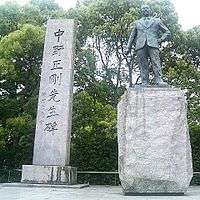Seigō Nakano

Seigō Nakano (中野 正剛 Nakano Seigō) (12 February 1886 – 27 October 1943) was a Japanese political leader who advocated a fascist Japan to complete the Meiji Restoration.
Nakano sought to bring about a rebirth of Japan through a blend of the samurai ethic, Neo-Confucianism, and populist nationalism modeled on European fascism. He saw Saigō Takamori as epitomizing the 'true spirit' of the Meiji ishin, and the task of modern Japan to recapture it.
Nakano formed the Kokumin Dōmei (National Alliance) with Adachi Kenzō in December 1932. He left this group with a splinter group to form the Tōhōkai (Far East Society, see their flag here) in May 1936.
In December 1937, Nakano had a personal audience with Benito Mussolini. In the next month, he met with Adolf Hitler and Joachim Ribbentrop.
In January 1939, Nakano gave a speech on the need for a totalitarian Japan. He argued against those who "say that neither fascism nor nazism are appropriate for our nation." He then distinguished between old-style, conservative despotism, and a "Totalitarianism… based on essentials." Arguing against majority rule (as the majority "is the precise cause of contemporary decadence") and "an individualism which shows no concern for others", he calls for a "government going beyond democracy" giving consideration to "the essence of human beings." With organic unification of individuals "sharing common ideals and a common way of feeling," there can be formed "a perfect national organization."
On 16 February 1942, British diplomats secretly proposed a peace deal with Japan. A possible agreement was that if Great Britain formally recognised the authority of Imperial Japan over North China and Manchuria, the Japanese would return sovereignty over the Malay Peninsula and Singapore to Britain.
At the same time as this diplomatic movement, a political confrontation was in progress between the Tōhōkai party and the Kōdōha party. This was possibly the last internal political power struggle in the government before the Midway and Coral Sea defeats in 1942, which sent the Japanese military reeling.
The ultranationalist Tōhōkai party was led by Nakano Seigō who had some political influence at the time and who expressed his support and confidence for the Imperial Japanese Navy. He anxiously awaited the approval of the peace talks, so as to stabilize the recent conquests in Southeast Asia. Seigō also wanted to prevent any further sacrifices by the Japanese people towards the war effort, and pressured the government to halt what he considered to be the overly-ambitious aim of conquering all of Asia.
On the other side was the largely pro-Imperialist faction, which represented the military interests of Japan and was led by General Hideki Tōjō, who reasoned that the extremely rapid successes in recent campaigns in Southeast Asia should be continued into the rest of Asia and even Australia before the Allies could react, to further develop the Greater East Asian Co-Prosperity Sphere.
General Tōjō rejected any form of peace processes in the conquered lands and gave authorization for more conquests. This angered and frustrated Nakano and the Tōhōkai, who saw the rejection as a lost opportunity for Japan to maintain and consolidate its new territorial gains in Southeast Asia in the long term, and before the United States launched counter-offensives.
Verbally critical of the Tōjō regime, Nakano was forbidden to publish articles or make public speeches. He committed seppuku (ritual suicide) on 27 October 1943 after being placed under house arrest.
See also
References
- Fascism (Oxford Readers) by Roger Griffin (Part III, B., iv. Japan), 1995, ISBN 0-19-289249-5
- Populist Nationalism in Pre-War Japan: A Biography of Nakano Seigo by Leslie Russel Oates, 1985, ISBN 0-86861-111-5 description
- "Nakano Seigo and the Spirit of the Meiji Restoration in Twentieth-Century Japan" by T. Najita in Dilemmas of Growth in Prewar Japan edited by James William Morley, ISBN 0-226-56803-2
External links
- Nakano, Seigo at National Diet Library, Japan
|